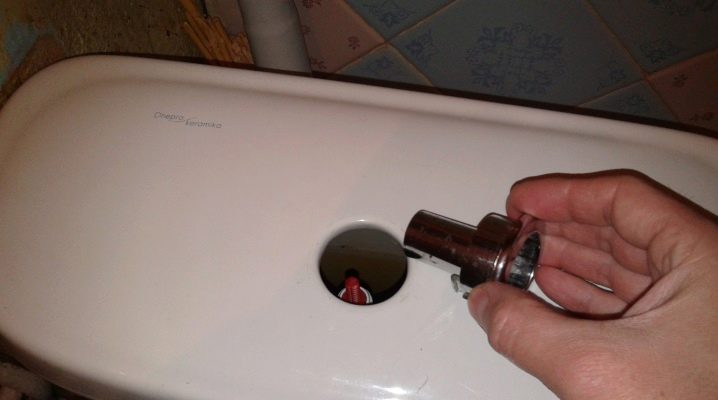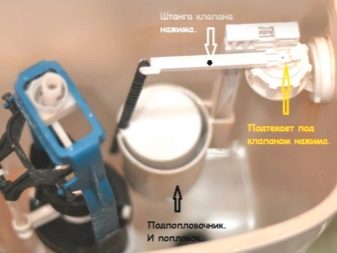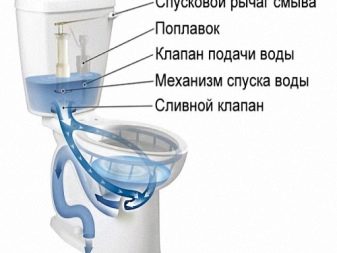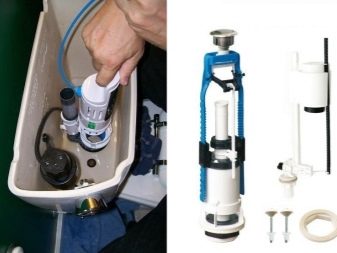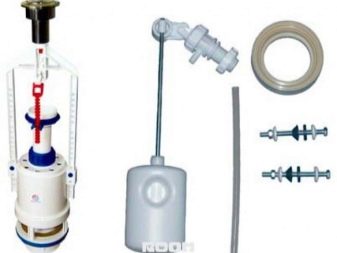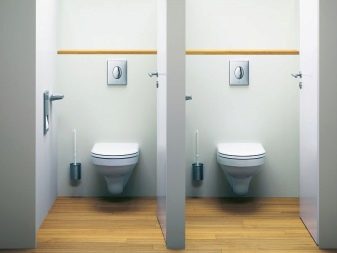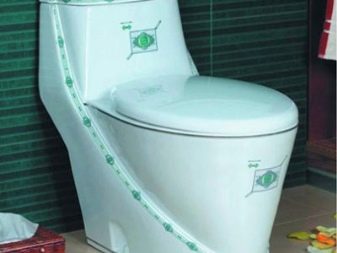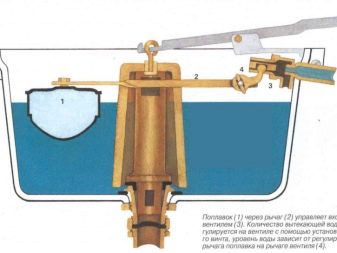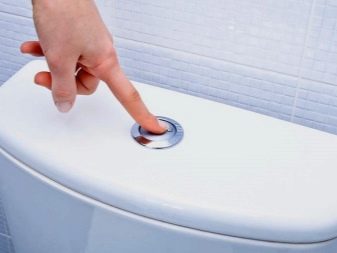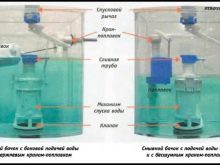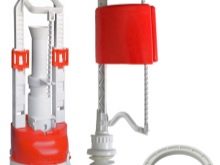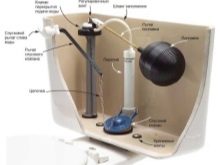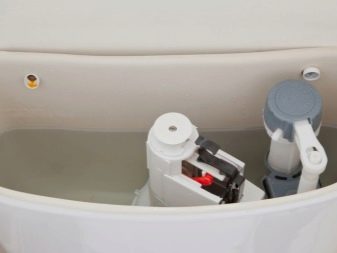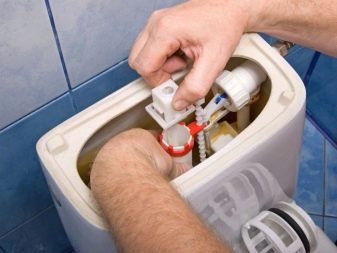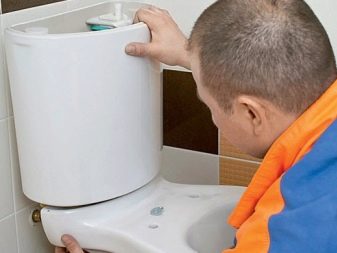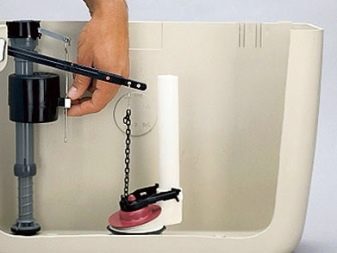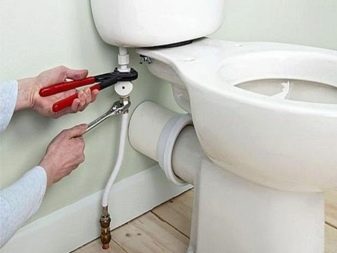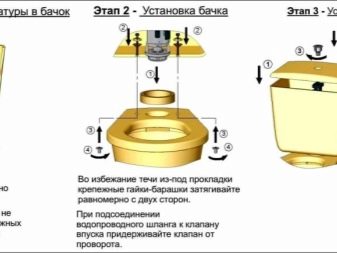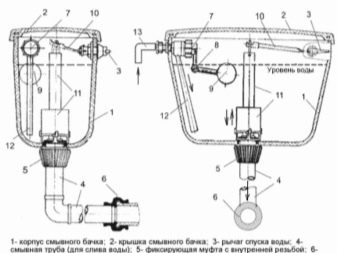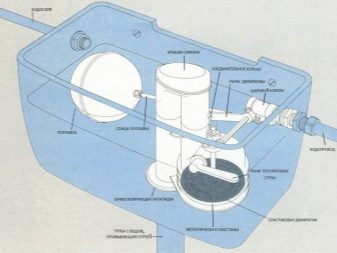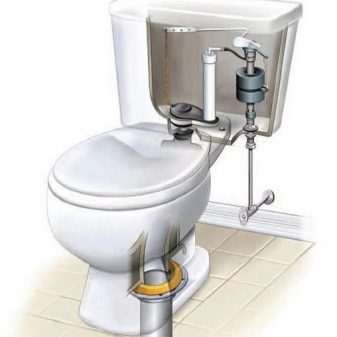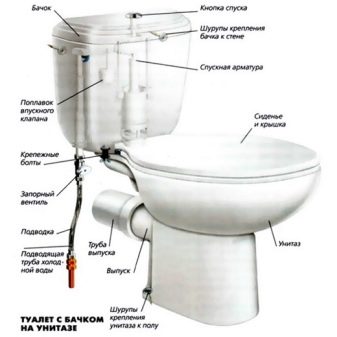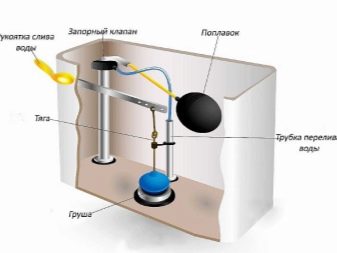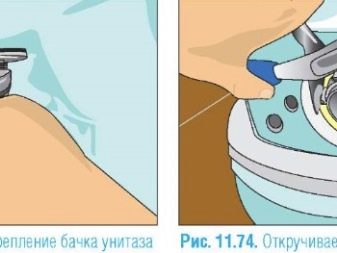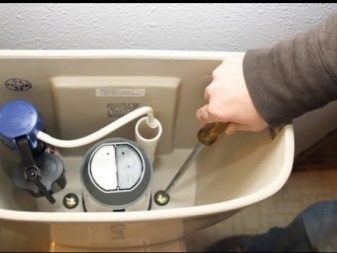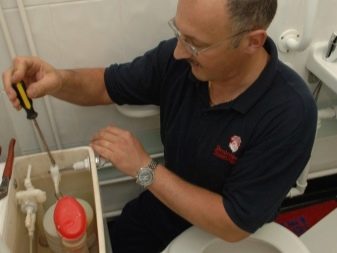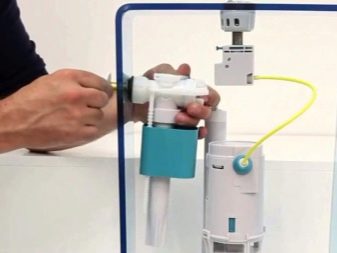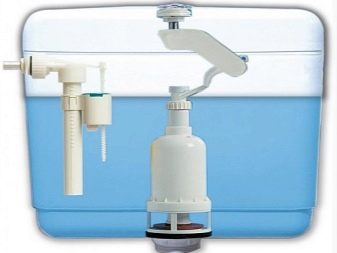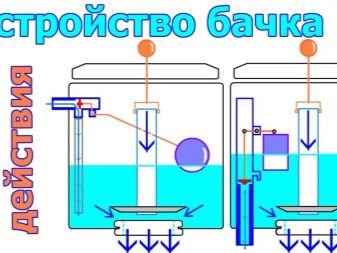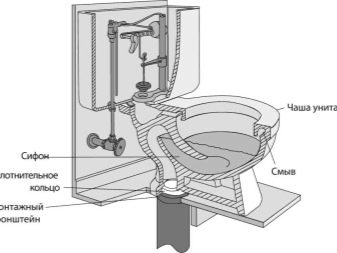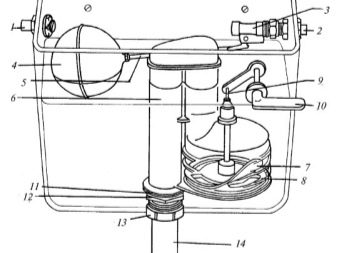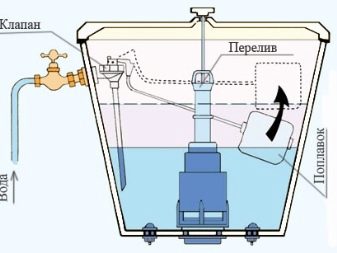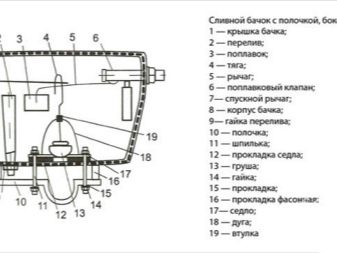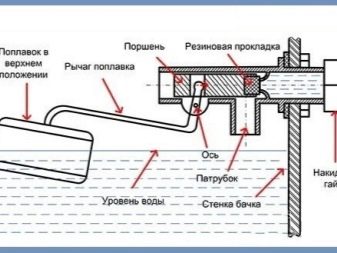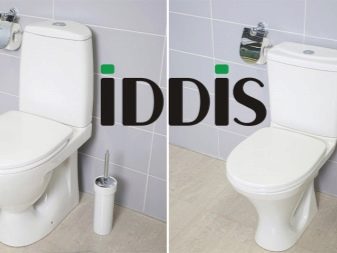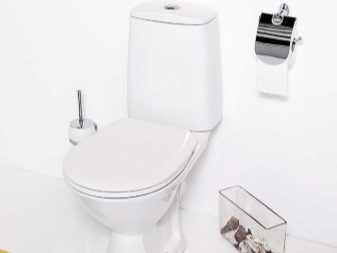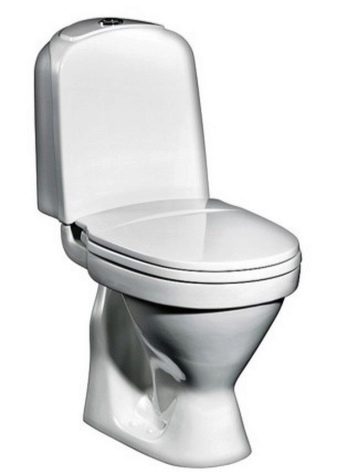Drain tank: causes and remedies
The leakage of the toilet cistern invariably causes a lot of trouble. Because of this, the hum of the flowing liquid is constantly heard, the surface of the bowl is covered with corrosion, condensate gradually accumulates on the pipes, due to which mold is formed. In addition, water bills increase significantly.
In order to avoid all these unpleasant consequences, all the flow of the tank must be eliminated as soon as possible. By the way, most of the problems are easy to fix by yourself, without resorting to the services of plumbers. However, for this you need to have at least a minimal understanding of the operation of this system and all its components.
Mechanism arrangement
In order to quickly eliminate the damage, you should get acquainted with the theoretical basics of the sanitary equipment device, namely, to find out how the water outlet from the sanitary device works.
Regardless of the operating parameters of the toilet bowl, absolutely any modification has two basic parts - a bowl and a drain tank. The bowl, as a rule, is located on the floor, but in recent years products built into the walls have become increasingly popular. The water tank is always located above the bowl. At the core of the water drain mechanism, the basic principle of the “hydraulic shutter” - assuming that the leakage under the influence of pressure generated by pressing on the lever (button) works.
Nowadays, plumbing stores can boast the widest selection of a variety of toilets and cisterns of all modifications. The latter, by the way, may differ depending on which attribute is taken as the basis of the classification.
The most common method of mounting the bowl, the relevance of which has not been declining for many decades, involves the installation of a single structure that combines both the toilet and the bowl, which are a single whole. The undoubted advantage of such plumbing is the lack of the need for pipes that would connect these two elements.The “compact” models belong to the same group - they are fastened to the rear ledge of the toilet bowl with the help of bolts through a gasket.
In recent years, mounted structures have become very popular when the tank is installed at a certain height from the bowl. This ensures a fairly strong water pressure and, accordingly, effective flushing. Such designs are quite durable and durable, they look stylish and are considered one of the most convenient to use, in addition, they can significantly save space in the bathroom. The only drawback of the installation can be called, perhaps, the loud sound of the discharge, heard at the time of the descent of the waters.
Hidden constructions are models from the “installation” category, one of the most fashionable trends. Such products are optimal for apartments and houses with European-quality repair. At the same time, the drain tank is mounted in the wall and closed with the help of panels and a sham wall, which makes it almost imperceptible, and the launch of the system occurs due to pressing a special panel.
By type of discharge, the tanks are conditionally divided into two categories.
- Lever - This system is widely represented in the models of the old types.Here, the water supply when flushing is regulated by a special lever, the raising of which opens an opening for draining.
- Push button - devices with two buttons that are in higher demand among consumers. The system allows you to save water, because it has two modes of operation - when pressing on one button only half of the water in the tank is poured out, and when pressing on both buttons - the full volume.
Fluid supply is regulated by the use of valves, which, in turn, is divided into several types.
- Lateral - this type is most common among domestic models of plumbing and assumes the location of fittings on top, not bottom. The undoubted advantage of such models is a rather low price, and the disadvantages are associated with an excessively noisy collection of water, which significantly reduces the level of comfort in the room.
- Bottom - These are more expensive models that raise noise to the lowest point. Models with such an eyeliner are produced both in Russia and abroad.
Drainage of water into the bowl is regulated by valves, it is this that prevents leakage without special need.The mechanism of action here is simple: as the tank is filled with liquid, water creates pressure, which leads to a noticeable pressure of the built-in valve to the drain in the bowl, due to this, the flow of water into the toilet stops. Therefore, in a situation where the water in the tank suddenly begins to run even after filling the tank, it can be stated with complete certainty that the failure is related to a violation of the functionality of the shut-off valves.
The role of the "regulator" of the fluid level in the slushbachke performs the valve. When reaching a given mark of water ends its flow into the tank. A peculiar indicator in this case is a special float, which is connected to the inlet valve by means of a brass rod.
If the earliest models of drainage mechanisms suggested placing the valve laterally and the float horizontally, more modern products are characterized by the vertical position of the float and the installation of the valve in the lower compartment of the drainage tank.
Drain and overflow of water are also supervised by a special mechanism that prevents water from overflowing when there are problems with the trigger valve.
Each of these elements may eventually fail and require repair or replacement. We will not review the problems associated with mechanical damage directly to the tank housing. Practice shows that such failures require the replacement of the entire tank, since even very resistant adhesives are ineffective when serious splits appear.
What is flowing and how to eliminate?
The leakage of the tank can occur for a variety of reasons, with absolutely every design of the drain mechanism is characterized by individual features, therefore, the way to eliminate problems in each case will be individual. However, the most common installation is a closed type model, which is why we consider the most common causes of leakage using the example of this design.
Depressurization
The first reason that the tank flowed - depressurization. In this case, a leak occurs in the area of the junction of the tank and the toilet bowl itself. As a rule, the cause here is the deformation or abrasion of the rubber seal.
You can fix the leak by installing a new gasket.
This work is carried out as follows:
- the water-pressure valve is closed, and, accordingly, the water supply stops;
- all residual moisture is removed from the tank with a sponge and absorbent cloth;
- Next, unscrew the drain nut, which is placed directly under the trigger hatch;
- all the screws with which the tank is attached to the toilet bowl, unscrew;
- the tank is dismantled;
- then it is required to unscrew the lock nut holding the drain, then the last one is taken out;
- mounted new gasket;
- the flush mechanism is fixed with new lock nuts;
- tank stops in its place and secured with hardware.
All gaskets are made for specific models of toilet bowls, they have different shapes and differ in size, so it is extremely important to choose the size you need for your particular mechanism. If the gasket is smaller or larger than required, the leakage problem will not go anywhere.
Rarely, but the causes of depressurization may lie elsewhere - when the bolt fixing the tank on the toilet bowl is rusting or the insulation that is responsible for the tightness of the hole for this bolt is wearing out.In such a case, you need to screw in a new bolt and put insulating gum.
The procedure is as follows:
- water supply is interrupted;
- the washer capacity is completely drained;
- all bolts are turned out and removed from the landing sites.
A sealing hermetic washer is attached to each bolt, after which they return to the joint and are tightened with nuts.
Sometimes even the replacement of insulation is not required - just enough to tighten the loose nut. However, do not be zealous - if you tighten the bolt too tight, the earthenware can simply go cracked.
All these actions are quite possible for a person without experience with plumbing, while the savings will be tangible: the replacement of materials you will need about 200 rubles for installation and about 100-300 rubles for a set of bolts (at 2017 prices). And the call of the master will cost at least 1200-1400 rubles.
Bias
The second cause of leakage is associated with the shift of the lever. To remedy the situation, simply returning it to its original position - horizontally horizontally just below the level of the pipe connection.
To eliminate other leaks associated with the lever, you must:
- raise the lid of the tank;
- slightly raise the float and try to adjust it.
If after that the water no longer flows and does not drip, then you need to unbend the axis of the float or replace it with a new one. If the flow does not stop, then look at the valve.
Pear
When the tank does not hold water and leaks, the reason may lie in the damage to the pear. In this case, the fluid continues to flow into the toilet even after flushing. As a rule, the reason for this is due to the fact that as the rubber component is in use, it loses its elasticity, becomes rigid, ceases to take the desired shape, and begins to crumble. It does not make sense to repair it - the pear cannot be restored, only a replacement of the element can help here.
When choosing the right pear, give preference to the softest product. Such models can be used for quite some time until it also hardens. To begin with, the pear should be rotated clockwise - this will remove the thread on the fastener, and then turn it again, but counter-clockwise, during assembly.
Tip: until you have purchased a pear, you can use a load suspended on a rod, for example, with any heavy nut.She will put pressure on the pear, thereby attaching it to the saddle.
Valve
The problem with the shut-off valve is often the reason that the tank is leaking. You can fix it. To do this, adjust the degree of pressure of the hatch on the element of the drain pipe, turning its end. But all these actions require a large investment of time and effort, and in addition, training, otherwise the situation can not only not be corrected, but also worsened.
It would be better to replace the entire tank or its drain node. To do this, as usual, for the beginning, shut off the water and drain the tank, and then remove all the fixing screws. Next, the tank itself is dismantled and the rubber gasket is replaced, the lock nuts are unscrewed and the entire previous mechanism is removed. It is replaced with a new one, and then all actions are repeated in the reverse order.
Please note that the new drain mechanism must be of the same model as the old one, or in case of emergency, of the same manufacturer. For example, if your broken tank is manufactured by Cersanit, then a new one should be made at the same factory.
In principle, such work is simple; any household craftsman who has captive keys and a couple of three-piece adjustable can replace the tank.If you are not confident in your abilities, then use the help of a professional. True, his services must be paid for, in 2017 the average check for such work was 1600-1800 rubles.
Bolts
A widespread breakage that leads to leakage of the cistern is the deformation of the bolts connecting the toilet and the cistern. Plastic fasteners burst, and metal are covered with rust - this causes the leakage.
To fix the situation you need to carefully inspect all valves. - It is highly likely that a single bolt is to be replaced. However, a specialist is recommended to buy a set of bolts. In any case, each of them is useful during the use of the toilet.
If most of the bolts are rusted and there is no possibility to unscrew and remove them, then you can cut them with a hacksaw, then the tank moves back and the shelf located on the cuff is removed. After that, the remains of rusty bolts are removed and the corrosion remaining in the holes is removed. New seals are installed for assembly and new bolts are screwed in. When fixing the latter, try not to allow any distortions, all movements should be soft,without effort and firm pressing, otherwise you can crush the earthenware and then the repair will require much larger amounts.
Overflow
Overflow and breakage of the flush tank may have other reasons. For example, buying a design with low-quality parts. If the problem is this, then you need to buy a new item, more reliable and quality. However, you can try to fix some defects “on the spot”. For example, if a small hole appeared in the float, then it can be sealed with the simplest polyethylene or a piece of plastic. For this, the material is heated above the fire of the lighter, after which the defect is “closed”. However, such a repair can only be a temporary solution to the problem; replacing a float that allows fluid to pass on to a new one will be required in any case.
Cracks
And finally, the cracks on the sides of the cistern or at its bottom. If the damage is small, you can try to cover them with high quality sealant. But, like the previous method, this method is designed for a temporary solution to the problem, the product will serve for a very short time and you still need to replace the cistern and the toilet bowl.
Mechanism with a button: features
The mechanism with the button requires a slightly different approach. To begin with we will focus on the features of such systems.
They are of several types:
- with a single button - while the water drains at a time when the button is held down;
- with one button, when the drain starts at the first short press and lasts until the second;
- with two buttons - while each of them produces a different volume of water with a different pressure flow.
The mechanism of action is different, but the principle is the same. When the valve is pressed, the device blocking the drain rises. At the same time, the stand itself remains motionless - that’s all the difference.
If water flows out of such an installation, first of all it is necessary to determine exactly which position the switch is in, and then try to establish the cause of the breakdown: when the button remains in the mine, the return spring most likely lost its elasticity. The lid of such a barrel will always be held in the "open" position.
The rest of the subsequence is the same here:
- remove the cover and switch;
- install a new spring;
- center the seat - it is located directly under the hole in the tank lid;
- reassemble.
Prevention: Tips
To the problem of plumbing and, in particular, with the toilet happened as rarely as possible, experts recommend a set of preventive measures. For this, it is advisable to thoroughly clean the toilet mechanism and the drain tank once every six months. It makes sense to regularly monitor the actual condition of fittings and valves.
Toilets very poorly tolerate temperature drops and mechanical damage.and if one or the other took place, the condition of the plumbing should be carefully checked, even if outwardly it looks serviceable.
timely prevention significantly extends the life of the entire system. If any leaks occur, the simple defects are eliminated first, and only after that they start to correct more serious problems.
Most often, the flow of the cistern can be eliminated without the involvement of specialists. The design itself is fairly simple. Its assembly / disassembly does not require special tools and professional skills, and spare parts can be purchased at any store. As a rule, their cost is low.
We have analyzed the most common causes of leakage.In 95% of cases, your problem is related to one of them. But if you replaced all the damaged parts, tightened the bolts and sealed the cracks, and the water still flows, then you should contact the plumber.
And, of course, an important factor affecting the life of the toilet, is the quality of the design. For a practical toilet you should go to a large plumbing store with a good reputation - there you can choose models for every taste and wallet for your toilet. At the same time, you can be sure that all the products are distinguished by their strength and high quality.
When purchasing a design, you need to pay attention to a number of points:
- there should not be any external defects, chips and cracks on the toilet cistern and toilet, the product should be covered evenly;
- the kit should include all the components necessary for installation;
- the product must necessarily be accompanied by instructions that will allow you to assemble the installation correctly, which will prevent the rapid appearance of leaks.
Manufacturers Overview
In conclusion, we will acquaint you with an overview of the manufacturers of toilet bowls and drain tanks, whose products have proven themselves in the market as reliable, practical and durable.
Sanita - a Russian brand that has been working since the middle of the last century - even in the war years, the company produced ceramics for the needs of the army, and in peacetime, the company repurposed its production facilities and engaged in the production of sanitary ware.
The advantage of products of this brand is relatively low cost, as well as:
- high quality materials used;
- installation of Swiss fittings;
- shower flush function.
The disadvantages include a weak plum, however, it is characteristic only for certain models of the brand.
IDDIS - another domestic manufacturer that has been successfully selling its products in the plumbing market for more than 10 years. Among Russian consumers, it is DDIS systems that are in greatest demand due to ease of use, ease of installation and low price.
Some models may have non-standard fasteners and this is a disadvantage, but, however, they do not affect the operation of the drain mechanism.
The category "comfort" includes products from leading European manufacturers.
Gustavsberg - a company from Sweden that mastered the production of toilet bowls more than 5 years ago.
These stylish products have excellent operational parameters:
- ease of installation;
- ease of use;
- economical water consumption;
- silent operation;
- high quality components.
At the same time, the models are very narrowly represented on the Russian market, which is why problems with the acquisition of spare parts may arise if systems break down. In addition, products of this brand are often forged in our country, so the purchase of an expensive installation can entail the risk of becoming the owner of a defective copy.
Jika - manufacturer from the Czech Republic. The company has been engaged in the release of toilet bowls since the 90s of the last century. During this time, the products of the brand have managed to establish themselves in the positions of the industry leader and win quite a few hearts of consumers in Russia. Today, the factory is part of the Roca group of companies and successfully sells sporting goods in most countries of the Eurasian continent.
Advantages of Jika products:
- durability;
- esthetic design;
- economical water consumption;
- large price range.
The disadvantages can be attributed to the high cost of repairs and spare parts, if a breakdown or leak occurs, then a rather significant amount will be required to eliminate it.Well, in addition, in stores often there is a shortage of, so be careful and check everything, without departing from the counter.
For premium models include Jacob Delafon. This is a manufacturer from France, who started production including toilet ceramics back in the nineteenth century. The product line of plumbing of this brand has more than 1000 items, products of the brand can be found in the most expensive homes, hotels and restaurants in the world.
The advantages are obvious: it is exceptionally high quality, impeccable design, quiet operation and economical water consumption. The disadvantages are also related to the level of the product - very few people undertake to repair such a product, and it is quite difficult to find components for plumbing.
How to eliminate the leak in the drain tank with your own hands, see the next video.
